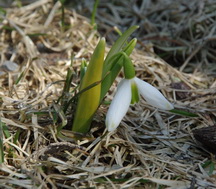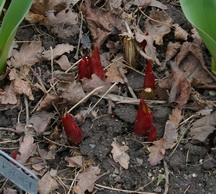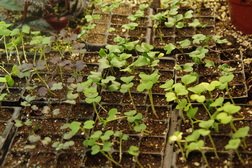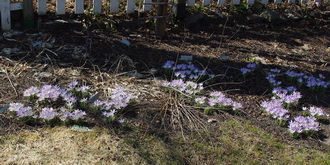

|
 The Witch Hazel is being a bit weird this year. This is also a good time to apologize for the layout of the last issue of Dallying In The Dirt. It was supposed to have two dated pictures of both the Snowdrops and the Witch hazel to show the differences between last year and this. Looked fine in the setup but many of you received a mess of overlapping pictures. You have to love technology!! Anyway the Witch Hazel is much slower blooming this year despite the earlier departure of the snow and the flowers that were mostly orange last year have so far been smaller and are a deep burgundy colour. Mother Nature wins again! I’m unreasonably excited by the late arrival of my oldest clump of Snowdrops. They are in the front grass and they were subjected to a lawn renovation last fall with new sod laid over top of them. They are late and small but they have managed to push their way through. Mother Nature and I both win!
The Witch Hazel is being a bit weird this year. This is also a good time to apologize for the layout of the last issue of Dallying In The Dirt. It was supposed to have two dated pictures of both the Snowdrops and the Witch hazel to show the differences between last year and this. Looked fine in the setup but many of you received a mess of overlapping pictures. You have to love technology!! Anyway the Witch Hazel is much slower blooming this year despite the earlier departure of the snow and the flowers that were mostly orange last year have so far been smaller and are a deep burgundy colour. Mother Nature wins again! I’m unreasonably excited by the late arrival of my oldest clump of Snowdrops. They are in the front grass and they were subjected to a lawn renovation last fall with new sod laid over top of them. They are late and small but they have managed to push their way through. Mother Nature and I both win! A few of the Hostas are starting to poke through and the bright red noses of the early Peonies are quite noticeable. There is no sign yet of my new Itoh Hybrid Peony, Garden Treasure. It was a rather expensive present from my children last year, I could never bring myself to spend that much for a single plant, and I’m hoping for great things from it. I know it will be late showing up and I hope my anxiety level can be controlled until then. Lots of Tulips and Narcissus making themselves obvious but no Asparagus yet. I’m really pushing it; even looking for it at the end of March, probably another month but it’s so warm and sunny today it just feels like it should be there. It will probably snow next week so that Mother Nature can remind me who’s in charge.
A few of the Hostas are starting to poke through and the bright red noses of the early Peonies are quite noticeable. There is no sign yet of my new Itoh Hybrid Peony, Garden Treasure. It was a rather expensive present from my children last year, I could never bring myself to spend that much for a single plant, and I’m hoping for great things from it. I know it will be late showing up and I hope my anxiety level can be controlled until then. Lots of Tulips and Narcissus making themselves obvious but no Asparagus yet. I’m really pushing it; even looking for it at the end of March, probably another month but it’s so warm and sunny today it just feels like it should be there. It will probably snow next week so that Mother Nature can remind me who’s in charge. Down in the basement there is a forest of seedlings appearing. It is amazing what happens when I follow my own seed starting advice. A look at the picture will give you some idea of the transplanting that lies ahead of me. I’ll do it during the snow storm next week so that I don’t have to miss any sunny days outdoors. I’m also going to have to get the heating cable in the outside cold frame plugged in so that it becomes a hot frame. As soon as I start all that transplanting I will run out of room under the lights. The Bonfire Begonias are growing quite well and are taking up a significant amount of that lighted space. I seem to have become infatuated with Begonias this year. I have acquired several new Tuberous Begonia tubers and they are now tucked into pots of soil and are sitting on the heat under the lights. Taking up yet more space there, that I was already short of. Great flowers, love the shade but break all my lazy gardener rules because they have to be unpotted and overwintered indoors and even my pond plants and fish don’t get that much attention in the autumn.
Down in the basement there is a forest of seedlings appearing. It is amazing what happens when I follow my own seed starting advice. A look at the picture will give you some idea of the transplanting that lies ahead of me. I’ll do it during the snow storm next week so that I don’t have to miss any sunny days outdoors. I’m also going to have to get the heating cable in the outside cold frame plugged in so that it becomes a hot frame. As soon as I start all that transplanting I will run out of room under the lights. The Bonfire Begonias are growing quite well and are taking up a significant amount of that lighted space. I seem to have become infatuated with Begonias this year. I have acquired several new Tuberous Begonia tubers and they are now tucked into pots of soil and are sitting on the heat under the lights. Taking up yet more space there, that I was already short of. Great flowers, love the shade but break all my lazy gardener rules because they have to be unpotted and overwintered indoors and even my pond plants and fish don’t get that much attention in the autumn.I was speaking at Canada Blooms, (our biggest spring flower show,) last week and they had a large market place where some of these things were very available at “show special” prices and and and... My talk on “Vertical Vegetables” was very well attended. Vegetables are “in” again. The seed companies are reporting that vegetable seeds are actually outselling flower seeds this year. Get out there and rip up the front lawn and plant some delicious and delightful food. Questions My newsletter subscribers get to ask me questions. Just ‘reply’ to the email newsletter. It is always interesting to read the questions; mostly to see if I actually can answer them or if I have to wade into the textbooks to research the answers. If that happens then we all learn something. Mardi Asks?I'm wondering if you can tell me how to get rid of milkweed. Over the last few years, I tried allowing a few to grow for Monarch butterflies and now they are literally invading my yard. I have tried pulling them up but that seems to encourage them. ? Ken Answers! There are other members of the milkweed family that are almost as good at attracting Monarch Butterflies but are much less invasive. You mentioned that you sprayed with Glufosinate, a, “kill everything green” herbicide and it works but very slowly. The other method works just as slowly. Every time you recognize a new small plant emerging, knock it down with a hoe. Eventually that deep, running root will run out of energy and quit. You cannot have just a few milkweed. Susan Asks? If starting plants indoors, when, where and for how long? Are there herbs that do well in the shade? Ken Answers! Just follow this link and all, or at least most, of your seed timing questions should be answered. Herbs that do well in the shade might be those where we are only interested in the leaves, not the flowers or seeds. Think Basil! Silvia Asks? I planted emerald cedars last June and they've been doing great over the winter. Now, as the temperature goes from minus 10 to plus 10 every other week, it seems they are starting to brown. THE PROBLEM is...this happened last year and we had to pull out 37 cedars. Ken Answers! From the pictures that you sent me I am going to offer a theory. The plants in the front yard, that are thriving, seem to be much more protected from the wind than the wide open back yard. As the sun shines and the wind blows the leaves on these Cedars start the process of transpiration. Passing water out through their pores. They then ask the roots to supply more water and the most of the water available is frozen. Two possible solutions, neither of which may help much at this point. All evergreens, especially newly planted ones should be well watered as late in the fall as possible. Evergreens, again particularly newly planted ones, need to be protected from strong winds and sunlight. It is not the cold that hurts them but the aforementioned sun and wind in late winter. I would find a way to cover at least the windward side of them with burlap for the first winter or two. There are also some chemical anti-desiccants that could be sprayed on them that might help. At this point I would just water them as soon and as much as possible. Good Luck. 111 Trent St. W. Whitby ON L1N1L9 |

